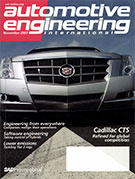Magazine

Automotive Engineering: March 2017
2017-03-02
Thought leadership at WCX17 Lucid Motors' David Moseley: EV or ICE, "It is all physics" New eye on the road One of the industry's hottest tech suppliers is blazing the autonomy trail by crowd-sourcing safe routes and using AI to learn to negotiate the road. Mobileye's co-founder and CTO explains. Hard, slick and ready to roll A tough, self-renewing catalyst coating developed at Argonne National Laboratory provides unprecedented friction and wear protection for vehicle powertrains, the inventors claim. Sensor ICs, semiconductors and safety To achieve ISO 26262 compliance, engineering practices must be taken to a higher level. The following insights may prove valuable for getting there. New VCR targets 40% BTE Variable-compression ratio with VVA from France's MCE-5.


















